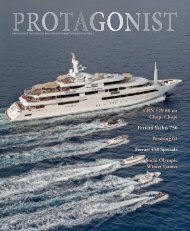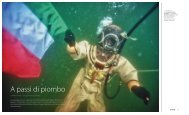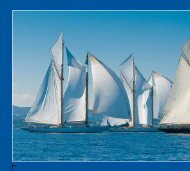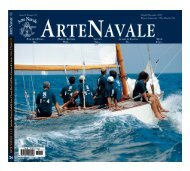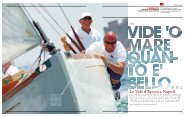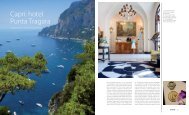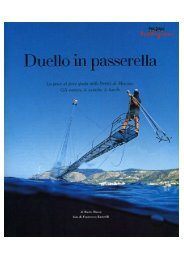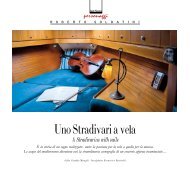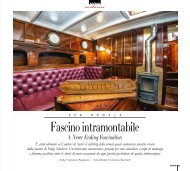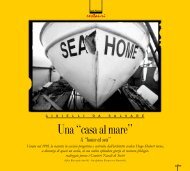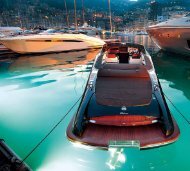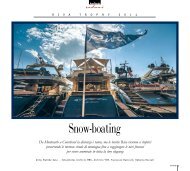Villaggi di pescatori in Scozia su Arte Navale
Reportage sui villaggi di pescatori dell'Est della Scozia
Reportage sui villaggi di pescatori dell'Est della Scozia
You also want an ePaper? Increase the reach of your titles
YUMPU automatically turns print PDFs into web optimized ePapers that Google loves.
luoghi <strong>di</strong> fasc<strong>in</strong>o<br />
A B E R D E E N S H I R E E B A N F F S H I R E<br />
Più forti del tempo e delle maree<br />
Stronger than Time and Tide<br />
Nell’est della <strong>Scozia</strong> c’è un tratto <strong>di</strong> costa che vive <strong>di</strong> quanto il Mare del Nord riesce a dargli. Con la pesca, ma anche<br />
e soprattutto con il turismo, attratto dal fasc<strong>in</strong>o dei piccoli paesi <strong>di</strong>ssem<strong>in</strong>ati <strong>su</strong>l litorale più panoramico del mondo<br />
<strong>di</strong>/by Roberta Roccati - foto/photo by Francesco Rastrelli<br />
29
30<br />
Quando si pensa alla <strong>Scozia</strong> l’immag<strong>in</strong>ario<br />
vola imme<strong>di</strong>atamente a<br />
lande sconf<strong>in</strong>ate <strong>su</strong> cui dom<strong>in</strong>ano<br />
castelli <strong>in</strong> pietra a rievocare l’orgoglio <strong>di</strong><br />
un antico popolo <strong>in</strong>domito. C’è però una<br />
parte dell’East Coast, identificabile nell’Aberdeenshire<br />
e Banffshire, che conserva<br />
<strong>in</strong> maniera esemplare i tratti <strong>di</strong>st<strong>in</strong>tivi <strong>di</strong><br />
una terra circondata dal Mare del Nord,<br />
da cui tutt’oggi cont<strong>in</strong>ua a trarre il proprio<br />
sostentamento. Se Aberdeen vive <strong>di</strong> un<br />
mare sfruttato dalle moderne piattaforme<br />
petrolifere, i tanti villaggi lungo i 200<br />
chilometri <strong>di</strong> questa costa, ritenuta dal Na-<br />
Sopra: il villaggio <strong>di</strong> Crovie, con i <strong>su</strong>oi cottage all<strong>in</strong>eati <strong>su</strong>lla riva.<br />
Nella pag<strong>in</strong>a a fianco, <strong>in</strong> alto: Pennan, pittoresco borgo <strong>di</strong> <strong>pescatori</strong> e, <strong>in</strong> basso:<br />
una veduta <strong>di</strong> Stonehaven da Dunnottar Castle.<br />
Above: Crovie, nestled under the hills along the shore. Top right: Pennan, a<br />
picturesque fish<strong>in</strong>g village. Bottom right: Stonehaven seen from Dunnottar Castle.<br />
When we th<strong>in</strong>k of Scotland, we<br />
imme<strong>di</strong>ately imag<strong>in</strong>e an endless<br />
countryside dom<strong>in</strong>ated by<br />
castles <strong>in</strong> stone, proud rem<strong>in</strong>ders of<br />
an ancient unconquered land. But <strong>in</strong><br />
Aberdeenshire and Banffshire we have<br />
a piece of the East Coast where the <strong>di</strong>stional<br />
Geographic tra le più panoramiche<br />
al mondo, sono rimasti <strong>in</strong><strong>di</strong>ssolubilmente<br />
legati alla grande tra<strong>di</strong>zione della pesca<br />
scozzese, non tanto perché venga ancora<br />
assiduamente praticata, quanto per la<br />
conservazione perfetta della struttura portuale<br />
del XIX secolo. L’identità <strong>di</strong> questi<br />
t<strong>in</strong>ctive traits of a land <strong>su</strong>rrounded by<br />
the North Sea are exemplary preserved<br />
and the <strong>in</strong>habitants still earn their liv<strong>in</strong>g<br />
from the sea. While Aberdeen prospers<br />
from modern offshore oil rigs, many of<br />
the villages are still closely tied to the<br />
great Scottish fish<strong>in</strong>g tra<strong>di</strong>tion. Scattered<br />
along 200 kilometers of coast,<br />
one of the most beautiful <strong>in</strong> the world<br />
accor<strong>di</strong>ng to National Geographic, the<br />
villages are <strong>in</strong>separably tied to fish<strong>in</strong>g:<br />
not because it is still widely practiced,<br />
but because of the perfectly preserved<br />
XIXth century system of harbors. The
31
orghi <strong>di</strong> <strong>pescatori</strong>, unita alla bellezza delle<br />
baie <strong>su</strong> cui si affacciano, è così peculiare<br />
da aver dato orig<strong>in</strong>e agli it<strong>in</strong>erari turistici<br />
Harbour Trail verso nord e Coastal Trail<br />
verso <strong>su</strong>d. Crovie, 40 chilometri a nord <strong>di</strong><br />
Aberdeen, è un <strong>su</strong>ggestivo paes<strong>in</strong>o nato nel<br />
1300 e sopravvis<strong>su</strong>to miracolosamente alla<br />
furia della natura. Adagiato <strong>su</strong>l mare, sotto<br />
una ripida parete rocciosa, venne fondato<br />
dalla gente cacciata dal latifon<strong>di</strong>sta locale<br />
per far posto ai pascoli <strong>di</strong> pecore e <strong>in</strong>iziò<br />
a prosperare agli <strong>in</strong>izi del 1800 grazie alla<br />
pesca praticata con ben 50 imbarcazioni<br />
costruite dai 200 residenti. Crovie non ha<br />
un vero porto ma solo un molo vic<strong>in</strong>o riva,<br />
a testimonianza del periodo <strong>in</strong>iziale della<br />
pesca ottocentesca <strong>su</strong> queste coste. In quel<br />
identity of these villages, and the beauty<br />
of the bays they face, are characterized<br />
by the north runn<strong>in</strong>g Harbour Trail and<br />
the south runn<strong>in</strong>g Costal Trail.<br />
Crovie, forty kilometers north of Aberdeen,<br />
is a picturesque hamlet from the<br />
1300’s, <strong>in</strong>cre<strong>di</strong>bly untouched by the fury<br />
of the elements. Set by the sea beneath<br />
steep rocky cliffs, Crovie was established<br />
by farmers driven from their land<br />
by the local landowner to make room for<br />
sheep graz<strong>in</strong>g. The town began to prosper<br />
<strong>in</strong> the early 1800’s thanks to a fish<strong>in</strong>g<br />
fleet of fifty vessels built by the two<br />
hundred <strong>in</strong>habitants. Crovie does not<br />
have a real harbor, just a jetty close to<br />
shore that exemplifies the early fish<strong>in</strong>g<br />
Sopra: un tra<strong>di</strong>zionale herr<strong>in</strong>g<br />
drifter per la pesca delle ar<strong>in</strong>ghe<br />
nel porto <strong>di</strong> Anstruther. Nella<br />
pag<strong>in</strong>a a fianco: nasse per la pesca<br />
delle aragoste <strong>su</strong>lla banch<strong>in</strong>a<br />
<strong>di</strong> Crail.<br />
Above: a tra<strong>di</strong>tional herr<strong>in</strong>g drifter<br />
<strong>in</strong> Anstruther Harbour. Right:<br />
lobster traps on the quay <strong>in</strong> Crail.<br />
32
33
Alcune piccole barche <strong>in</strong> legno<br />
ancora <strong>in</strong> uso nel porto <strong>di</strong> Portsoy,<br />
costruito con pietre <strong>di</strong>sposte <strong>in</strong><br />
verticale.<br />
periodo, <strong>in</strong>fatti, venivano usate piccole<br />
barche a vela, a uno o due alberi, che non<br />
si avventuravano lontano dalla terraferma<br />
perché non pontate e <strong>in</strong>stabili <strong>in</strong> con<strong>di</strong>zioni<br />
<strong>di</strong> maltempo. Le violente tempeste del<br />
1848 portarono all’<strong>in</strong>troduzione <strong>di</strong> barche<br />
dotate <strong>di</strong> coperta, più pesanti, <strong>in</strong> grado <strong>di</strong><br />
affrontare il mare aperto e <strong>di</strong> aumentare<br />
il pescato. Questo tipo <strong>di</strong> imbarcazione,<br />
a vela quadra, <strong>di</strong>venne la base della flottiglia<br />
da pesca, nelle <strong>su</strong>e <strong>di</strong>verse varianti<br />
Skaffie, Fifie e Zulu e rese necessaria la<br />
trasformazione delle banch<strong>in</strong>e <strong>in</strong> veri e<br />
propri porti riparati. Il 31 gennaio 1953 una<br />
terribile mareggiata travolse Crovie, ma<br />
il borgo non venne demolito e oggi le case<br />
imbiancate a calce, all<strong>in</strong>eate lungo l’unica<br />
via pedonale del paese, guardano le onde<br />
<strong>in</strong>frangersi <strong>su</strong>lle rocce <strong>in</strong> un silenzio irreale,<br />
che sospende questo delizioso paese fuori<br />
dal tempo e dalle rotte del vivere quoti<strong>di</strong>ano.<br />
Pennan, nato con il porto del 1704 come<br />
villaggio <strong>di</strong> <strong>pescatori</strong>, è <strong>in</strong>vece un pittoresco<br />
paes<strong>in</strong>o portuale <strong>di</strong> casette <strong>di</strong>sposte <strong>in</strong><br />
34
Several small wooden boats still<br />
<strong>in</strong> use <strong>in</strong> Portsoy, where you see<br />
the harbor walls and their vertical<br />
stones.<br />
period along the coast. Then small sailboats<br />
were used, with one or two masts,<br />
which never sailed far from the coast<br />
as they were open boats and unstable<br />
<strong>in</strong> heavy weather. The violent storms<br />
of 1848 brought about the <strong>in</strong>troduction<br />
of heavier decked craft, able to <strong>su</strong>rvive<br />
the open sea and <strong>in</strong>crease their catch.<br />
These square rigged vessels became the<br />
basis of the fish<strong>in</strong>g fleet, and variations<br />
<strong>in</strong> design, with Skaffie, Fifie and Zulu<br />
craft, called for the transformation of<br />
the jetties <strong>in</strong>to protected harbors. On<br />
January 31 st , 1953, a terrible storm<br />
damaged Crovie, but the town <strong>su</strong>rvived<br />
and today, with the whitewashed houses<br />
l<strong>in</strong><strong>in</strong>g the town’s only pedestrian street,<br />
it overlooks the waves that break over<br />
the rocks <strong>in</strong> an unreal silence, <strong>su</strong>spen<strong>di</strong>ng<br />
this delightful town out of time and<br />
away from the paths of daily life.<br />
Established together with its harbor <strong>in</strong><br />
1704, the picturesque fish<strong>in</strong>g village of<br />
Pennan is made up of a s<strong>in</strong>gle row of<br />
35
La tra<strong>di</strong>zione marittima<br />
della East Coast è presente<br />
anche nei dettagli della vita<br />
quoti<strong>di</strong>ana.<br />
The maritime tra<strong>di</strong>tion of the<br />
East Coast is visible <strong>in</strong> details<br />
of daily life.<br />
36
37
un’unica fila, nascosto sotto l’alta scogliera<br />
<strong>di</strong> arenaria rossa. Generazioni <strong>di</strong> uom<strong>in</strong>i<br />
delle famiglie Watt, Gatt e West hanno<br />
affrontato il Mare del Nord con una flotta<br />
<strong>di</strong> circa 40 herr<strong>in</strong>g drifters (barche a vela <strong>in</strong><br />
legno per la pesca delle ar<strong>in</strong>ghe con la rete<br />
da posta) <strong>in</strong> cerca del pesce che le donne e i<br />
ragazzi del villaggio avrebbero poi venduto<br />
nell’entroterra; dal porto partivano anche<br />
le navi per trasportare le pietre delle famose<br />
cave locali. Negli ultimi 50 anni, molte<br />
<strong>di</strong> quelle famiglie si sono trasferite altrove<br />
e il turismo è cresciuto, grazie anche al film<br />
Local Hero, del 1983, ambientato proprio<br />
qui. Il villaggio <strong>in</strong> pietra <strong>di</strong> Portsoy vanta<br />
ben 2 porti, entrambi centenari e perfettamente<br />
conservati. Il primo venne costruito<br />
nel 1693 e fu uno dei più sicuri della <strong>Scozia</strong>:<br />
si presenta come un bac<strong>in</strong>o chiuso da alte<br />
mura, realizzate con gran<strong>di</strong> pietre poste <strong>in</strong><br />
In questa pag<strong>in</strong>a: gli allievi<br />
della Stonehaven Sea Cadets si<br />
esercitano durante le lezioni <strong>di</strong><br />
arte mar<strong>in</strong>aresca. Nella pag<strong>in</strong>a a<br />
fianco: f<strong>in</strong>estra con vista a Portsoy.<br />
Left: students from the Stonehaven<br />
Sea Cadets practice row<strong>in</strong>g.<br />
Right: the view from a w<strong>in</strong>dow <strong>in</strong><br />
Portsoy.<br />
cottages, sheltered under a high red<br />
sandstone cliff. Generations of men<br />
from the Watt, Gast and West families<br />
have dared the North Sea <strong>in</strong> a forty<br />
strong fleet of gillnet herr<strong>in</strong>g drifters<br />
<strong>in</strong> search of the fish that the villages<br />
women and children would sell <strong>in</strong>land;<br />
ships from the port also transported<br />
rocks from the famous local quarries.<br />
Over the last fifty years many families<br />
have moved elsewhere and tourism has<br />
<strong>in</strong>creased thanks to the film<strong>in</strong>g of the<br />
1983 movie “Local Hero”.<br />
The stone village of Portsoy has two<br />
harbors, both centuries old and <strong>in</strong> perfect<br />
con<strong>di</strong>tion. The first was built <strong>in</strong><br />
1693 and was one of the best ports <strong>in</strong><br />
Scotland: the <strong>in</strong>ner bas<strong>in</strong> is <strong>su</strong>rrounded<br />
38
39
40
Nella pag<strong>in</strong>a a fianco: barche<br />
spiaggiate dalla bassa marea a<br />
Earlsferry. Sopra: il fish’n’chips<br />
shop <strong>di</strong> Anstruther, uno tra i<br />
migliori del Regno Unito.<br />
Left: dry<strong>in</strong>g out at low tide<br />
<strong>in</strong> Earlsferry. Above: the<br />
fish’n’chip shop of Anstruther,<br />
one of the best <strong>in</strong> the United<br />
K<strong>in</strong>gdom.<br />
verticale perché ritenute <strong>in</strong> tal modo più<br />
resistenti all’impatto dei flutti. Il nuovo<br />
porto, risalente al 1825, venne costruito<br />
per ospitare barche de<strong>di</strong>te al contrabbando,<br />
come testimoniato dai passaggi segreti<br />
<strong>di</strong> collegamento tra il porto e alcune abitazioni<br />
del paese, al trasporto del famoso<br />
marmo <strong>di</strong> Portsoy, utilizzato ad<strong>di</strong>rittura<br />
per i cam<strong>in</strong>etti <strong>di</strong> Versailles, e a quello del<br />
salmone affumicato. La tra<strong>di</strong>zione mar<strong>in</strong>ara<br />
del paese è ben esposta nelle ex camere<br />
refrigeranti e <strong>di</strong> deposito delle nasse al Salmon<br />
Bothy Museum. Imper<strong>di</strong>bile è anche<br />
lo Scottish Tra<strong>di</strong>tional Boat Festival, che<br />
si tiene <strong>in</strong> giugno o luglio, a seconda delle<br />
maree: cent<strong>in</strong>aia <strong>di</strong> imbarcazioni tra<strong>di</strong>zionali<br />
si affollano nei porticcioli, mentre <strong>su</strong>lle<br />
banch<strong>in</strong>e i mastri d’ascia danno <strong>di</strong>mostrazione<br />
delle loro abilità costruttive. La costa<br />
più a <strong>su</strong>d ospita un’attività <strong>di</strong> pesca ancora<br />
fervente: a Stonehaven, Anstruther, Crail e<br />
Earlsferry gli herr<strong>in</strong>g drifters hanno lasciaby<br />
high walls made of vertically placed<br />
large stones to better withstand the<br />
impact of the sea. The more recent<br />
harbor, built <strong>in</strong> 1825, was built to shelter<br />
vessels engaged <strong>in</strong> smuggl<strong>in</strong>g, with<br />
secret passages connect<strong>in</strong>g the port to<br />
houses <strong>in</strong> the village, ships transport<strong>in</strong>g<br />
the famous Portsoy marble, used <strong>in</strong> the<br />
fireplaces of Versailles, and <strong>in</strong> the commerce<br />
of smoked salmon. The town’s<br />
seago<strong>in</strong>g tra<strong>di</strong>tions are well illustrated<br />
<strong>in</strong> the Salmon Bothy Museum, found<br />
<strong>in</strong> the town’s old cold rooms and creel<br />
deposit. The Scottish Tra<strong>di</strong>tional Boat<br />
festival is not to be missed. Held <strong>in</strong><br />
June or July, depen<strong>di</strong>ng on the tides,<br />
hundreds of tra<strong>di</strong>tional vessels crowd<br />
the harbors, while along the quays shipbuilders<br />
show off their skills. Farther<br />
south the coast hosts even more active<br />
fish<strong>in</strong>g: <strong>in</strong> Stonehaven, Anstruther and<br />
Craile Earlsferry the herr<strong>in</strong>g trawlers<br />
41
42<br />
Una foto d’epoca <strong>di</strong> <strong>pescatori</strong> <strong>di</strong> ar<strong>in</strong>ghe nel Museo Marittimo <strong>di</strong> Aberdeen.<br />
A period image of herr<strong>in</strong>g fishermen from the Aberdeen Maritime Museum.<br />
trici, capesante, aragoste e eglef<strong>in</strong>i, pronti<br />
per gli eccellenti ristoranti del lungomare o<br />
per le smoke house, con negozietti annessi,<br />
che preparano piatti pronti per i numerosi<br />
turisti. Lo scozzese Robert Burns scrisse<br />
“Nae man can tether time or tide” (l’uomo<br />
non può controllare il tempo o la marea):<br />
<strong>su</strong>lla East Coast sembrano esserci riusciti.<br />
to il posto ai trawler per la pesca a strascico<br />
e ai moderni pescherecci che usano reti<br />
a circuizione per i pelagici e nasse per i<br />
crostacei. Ai tipici porti del secolo scorso,<br />
con la loro struttura circolare dalle alte<br />
mura, sono state spesso aggiunte chiuse <strong>in</strong><br />
entrata, per contrastare la notevole escursione<br />
delle maree e non lasciare <strong>in</strong> secca le<br />
barche più gran<strong>di</strong>. Siamo nella regione del<br />
fish’n’ chips e dei frutti <strong>di</strong> mare: ogni giorno<br />
la banch<strong>in</strong>a si anima quando i <strong>pescatori</strong> rientrano<br />
con merluzzi, platesse, rane pescahave<br />
<strong>su</strong>ccumbed to ocean go<strong>in</strong>g trawlers<br />
and modern fish<strong>in</strong>g boats that use<br />
se<strong>in</strong>e nets for fish and traps for the<br />
shellfish.<br />
These century old ports, with their circular<br />
walls, now are often fitted with<br />
locks to limit the considerable tides and<br />
keep the larger vessels afloat. This is<br />
the area for fish’n’chips and seafood:<br />
each day the quays fill with fisherman<br />
return<strong>in</strong>g with their catch – cod,<br />
flounder, monkfish, scallops, lobster<br />
and haddock, dest<strong>in</strong>ed for the excellent<br />
seaside restaurants or the smoke<br />
houses with their stores that prepare<br />
ready made <strong>di</strong>shes for the pass<strong>in</strong>g tourists.<br />
The Scottish author Robert Burns<br />
wrote: “Nae man can tether time or<br />
tide”: but on the East Coast they seem<br />
to have done both.




